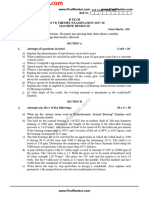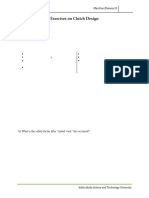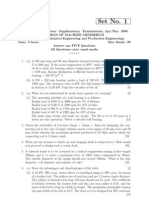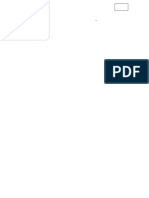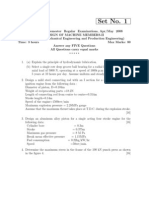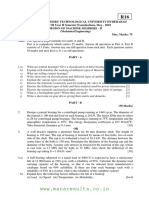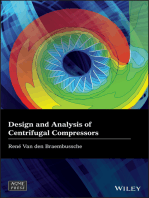Bearing Excercise
Bearing Excercise
Uploaded by
imisschesaCopyright:
Available Formats
Bearing Excercise
Bearing Excercise
Uploaded by
imisschesaCopyright
Available Formats
Share this document
Did you find this document useful?
Is this content inappropriate?
Copyright:
Available Formats
Bearing Excercise
Bearing Excercise
Uploaded by
imisschesaCopyright:
Available Formats
Addis Ababa Science and Technology University
College of Electrical and Mechanical Engineering
Department of Mechanical Engineering
Design of Machine Elements II
Exercise on Rolling Contact Bearings
1) A ball bearing with a dynamic load capacity of 22.8 kN is subjected to a radial load of 10 kN. Calculate
(i) The expected life in million revolutions that 90% of the bearings will reach;
(ii) The corresponding life in hours, if the shaft is rotating at 1450 rpm; and
(iii) The life that 50% of the bearings will complete or exceed before fatigue failure.
[(i) 11.85 (ii) 136.23 (iii) 681.17]
2) A cylindrical roller bearing with bore diameter of 40 mm is subjected to a radial force of 25 kN. The
coefficient of friction is 0.0012 and the speed of rotation is 1440 rpm. Calculate the power lost in friction.
3) A ball bearing is subjected to a radial force of 2500 N and an axial force of 1000 N. The dynamic load
carrying capacity of the bearing is 7350 N. The values of X and Y factors are 0.56 and 1.6 respectively. The
shaft is rotating at 720 rpm. Calculate the life of the bearing.
4) A ball bearing operates on the following work cycle:
Element No. Radial load (N) Speed (rpm) Element time (%)
1 3000 720 30
2 7000 1440 50
3 5000 900 20
The dynamic load capacity of the bearing is 16.6 kN.
Calculate
(i) The average speed of rotation; (ii) the equivalent radial load; and (iii) the bearing life.
[(i) 1116 rpm (ii) 6271.57 N (iii) 276.94 h]
5) A system involves four identical ball bearings, each subjected to a radial load of 2500 N. The reliability of
the system, i.e., one out of four bearings failing during the lifetime of five million revolutions, is 82%.
Determine the dynamic load carrying capacity of the bearing, so as to select it from the manufacturer’s
catalogue based on 90% reliability.
6) Select a ball bearing for an industrial machine press fit onto a shaft and intended for continuous one-shift (8-
hour day) operation at 1800 rpm. Radial and thrust loads are 1.2 and 1.5 kN, respectively, with light-to-
moderate impact. A ball bearing operates 8 hours per day, 5 days per week, and carries constant radial and
thrust loads. Bearing life of 30,000 hr is required.
7) The Figure below shows two bearings supporting a 1000-rpm shaft and gear. The bearing on the left carries
a 5-kN radial load and 1-kN thrust load. The loading is border line between “light” and “moderate” impact.
The required life is 5000 hours with only 2% probability of failure. Select a 200 series radial-contact ball
bearing for the left bearing.
Design of Machine Elements II Page 1 of 3
8) Figure below shows a cantilevered chain idler sprocket driven by a roller chain that applies a 1200-lb force.
Select identical 200 series ball bearings for A and B. The shaft rotates at 350 rpm
Exercise on Sliding Contact Bearings (Journal Bearings)
1) Using the following given parameters: µ = 27.56 mPa-s, n = 30 rev/s W = 2225 N (bearing load), r = 19
mm, c = 0.0381 mm, and l = 38 mm. Determine:
a) Minimum film thickness e) The power loss to friction
b) Eccentricity f) The total volumetric flow rate Q and the side flow
c) Coefficient of friction rate Qs.
d) The torque to overcome friction g) The maximum film pressure and the locations of the
maximum and terminating pressures.
2) A journal bearing 120 mm in diameter and 60 mm long has a diametral clearance of 0.20 mm. The journal
rotates 3000 rpm and is lubricated with SAE 20 oil at an average temperature of 70°C. Using Petroff’s
equation, estimate the power loss and the friction torque.
[Ans.: 1.01 kW, 3.2 N-m]
3) The following data is given for a hydrostatic thrust bearing:
Shaft speed = 720 rpm Viscosity of lubricant = 30 cP
Shaft diameter = 400 mm Specific gravity = 0.86
Recess diameter = 250 mm Specific heat = 1.75 kJ/kg°C
Film thickness = 0.15 mm Supply pressure = 5 MPa
Calculate
(i) Load carrying capacity of the bearing; (ii) flow requirement; (iii) pumping power loss;
(iv) Frictional power loss; and (v) temperature rise.
Assume that the total power loss in the bearing is converted into frictional heat.
4) A 360° hydrodynamic bearing operates under the following conditions:
Radial load = 50 kN Radial clearance = 0.15 mm
Journal diameter = 150 mm Minimum film thickness = 0.03 mm
bearing length = 150 mm Viscosity of lubricant = 8 cP
What is the minimum speed of operation for the journal to work under hydrodynamic conditions?
Design of Machine Elements II Page 2 of 3
5) The following data is given for a 360° hydrodynamic bearing:
Journal diameter = 100 mm Journal speed = 1440 rpm
Bearing length = 100 mm Radial clearance = 0.12 mm
Radial load = 50 kN Viscosity of lubricant = 16 cP
Calculate (i) minimum film thickness; (ii) coefficient of friction; and (iii) power lost in friction.
6) The following data is given for a full hydrodynamic bearing:
radial load = 25 kN viscosity of lubricant = 20 cP
journal speed = 900 rpm class of fi t = H7e7
unit bearing pressure = 2.5 MPa
(l/d) ratio =1
Calculate (i) dimensions of the bearing (ii) minimum film thickness, and (iii) requirement of oil flow. (Shigley)
7) A full journal bearing has a shaft journal diameter of 25 mm with a unilateral tolerance of −0.01 mm. The
bushing bore has a diameter of 25.04 mm with a unilateral tolerance of 0.03 mm. The l/d ratio is unity. The
bushing load is 1.25 kN, and the journal rotates at 1200 rev/min. Analyze the minimum clearance assembly
if the average viscosity is 50 mPa · s to find the minimum oil film thickness, the power loss, and the
percentage of side flow.
8) A full journal bearing has a shaft journal with a diameter of 30.00 mm and a unilateral tolerance of −0.015
mm. The bushing bore has a diameter of 30.05 mm with a unilateral tolerance of 0.035 mm. The bushing
bore is 50 mm in length. The bearing load is 2.75 kN and the journal rotates at 1120 rev/min. Analyze the
minimum clearance assembly and find the minimum film thickness, the coefficient of friction, and the total
oil flow if the average viscosity is 60 mPa · s.
a
O
b
9)
Design of Machine Elements II Page 3 of 3
You might also like
- Drilling Rig Inspection Program 5 Year, 2 Year, 1 Year 6 Months, Monthly88% (8)Drilling Rig Inspection Program 5 Year, 2 Year, 1 Year 6 Months, Monthly76 pages
- B.Tech Degree S8 (S, FE) / S6 (PT) (S, FE) Examination June 2023 (2015 Scheme)No ratings yetB.Tech Degree S8 (S, FE) / S6 (PT) (S, FE) Examination June 2023 (2015 Scheme)3 pages
- Attempt All Sections. If Require Any Missing Data Then Choose Suitably. Standard Design Data Book Is AllowedNo ratings yetAttempt All Sections. If Require Any Missing Data Then Choose Suitably. Standard Design Data Book Is Allowed3 pages
- MET401 DESIGN OF MACHINE ELEMENTS, DECEMBER 2023No ratings yetMET401 DESIGN OF MACHINE ELEMENTS, DECEMBER 20233 pages
- The Copperbelt University School of EngiNo ratings yetThe Copperbelt University School of Engi3 pages
- II B.Tech II SEM DOM Question Paper 2023No ratings yetII B.Tech II SEM DOM Question Paper 20233 pages
- WWW - Manaresults.Co - In: (Common To Ame, Me)No ratings yetWWW - Manaresults.Co - In: (Common To Ame, Me)3 pages
- 1 ST Assignment Section-A&B 3-1 Semester Dmm-2: Sir CR Reddy College of EngineeringNo ratings yet1 ST Assignment Section-A&B 3-1 Semester Dmm-2: Sir CR Reddy College of Engineering3 pages
- Ilovepdf - Merged - 2024-02-25T160140.090No ratings yetIlovepdf - Merged - 2024-02-25T160140.09010 pages
- Me 7 Sem Subject Design of Mechanical Drives Jun 2017No ratings yetMe 7 Sem Subject Design of Mechanical Drives Jun 20172 pages
- WWW - Manaresults.co - In: (Mechanical Engineering)No ratings yetWWW - Manaresults.co - In: (Mechanical Engineering)2 pages
- Materials Science and Technology of Optical FabricationFrom EverandMaterials Science and Technology of Optical FabricationNo ratings yet
- Drilling Bits and Hydraulics Calculation PDF100% (4)Drilling Bits and Hydraulics Calculation PDF197 pages
- FreeMotion Cable Crossover Functional TrainerNo ratings yetFreeMotion Cable Crossover Functional Trainer8 pages
- Group 2 Removal and Installation of Unit: 1. MastNo ratings yetGroup 2 Removal and Installation of Unit: 1. Mast17 pages
- Training Manual: Hydrastar H300 - TR - ENNo ratings yetTraining Manual: Hydrastar H300 - TR - EN9 pages
- Goulds LF 3171: Low Flow, High Head Vertical Sump PumpNo ratings yetGoulds LF 3171: Low Flow, High Head Vertical Sump Pump4 pages












